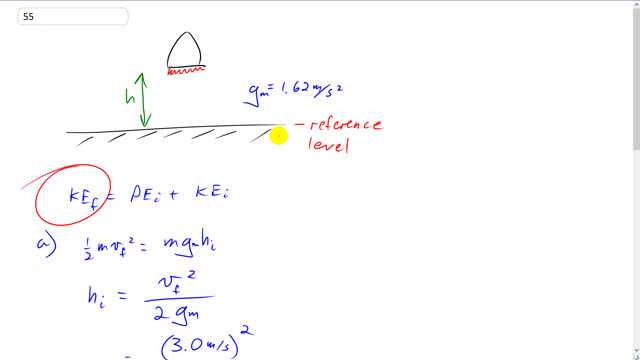
The Lunar Module could make a safe landing if its vertical velocity at impact is 3.0 m/s or less. Suppose that you want to determine the greatest height at which the pilot could shut off the engine if the velocity of the lander relative to the surface at that moment is
- zero;
- 2.0 m/s downward;
- 2.0 m/s upward.

In order to watch this solution you need to have a subscription.
This is Giancoli Answers with Mr. Dychko. The total final energy of this lunar lander at the ground level is gonna consist only of kinetic energy because we'll take the ground to be the reference level, in which case, there's no height there for gravitational potential energy. And then initially, they have some potential energy and some kinetic energy, at least in part (b) and (c), it has kinetic energy; in part (a), there's no initial kinetic energy, it's only potential energy. So, we are gonna figure out what maximum height the lunar lander could begin its landing from based on this constraint that the final speed, when it hits the ground, it can be no more than 3 meters per second. So, we'll solve for h by setting the final kinetic energy equal to the initial potential energy and we'll cancel the m's here. And divide both sides by g on the moon; acceleration due to gravity on the moon, and then switch the sides around and we get initial height is final speed squared divided by 2 times g. So, that's 3 meters per second and square that; divided by 2 and divide by 1.62 meters per second squared; acceleration due to gravity on the moon, and we get 2.8 meters. Parts (b) and (c) are exactly the same except that v is, the initial speed is, either positive or negative. But either way, when we square that speed, we are gonna get a positive result of that squaring and so that's an algebraic reason for why the direction of the initial speed doesn't matter. Another way to think of it is that well, the total final energy that it has, has to be equal to the total initial energy it has. And this initial kinetic energy that it has is the same, regardless of whether it's going up or down because it's, the energy is all to do with its speed; doesn't matter what the direction of that speed is, it has the same kinetic energy. So, we'll solve this for h i by taking this term to the left side, which makes it minus, and then we are gonna cancel the m's everywhere and then divide both sides by g m; times by 1 over g m, another way to say that; has a common denominator 2 here as well because they are both multiplied by half. So, we have initial height is v final squared minus v initial squared over 2 times gm. And that's 3 meters per second, square that, minus the 2 meters per second speed it has initially, squared divided by 2 and divide by 1.62 meters per second squared. And so the height is now 1.5 meters and we expected reduction, compared to our answer in part (a) because there's an initial speed here that it won't be allowed to drop as far so there won't be room for it to go as high. They won't be allowed to have as much initial gravitational potential energy and hence, a smaller initial height because there's also this kinetic energy there.